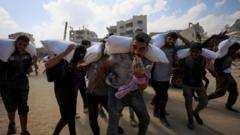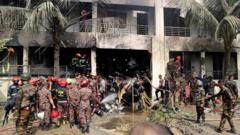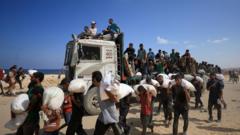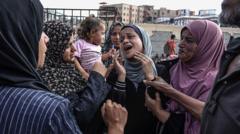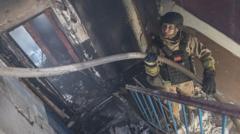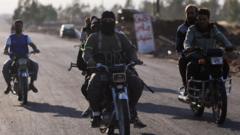In a distressing weekend of violence, two separate shootings over two days underscored the inherent dangers facing Palestinians reliant on aid in Gaza.
Deadly Shootings Expose Risks in Gaza Aid Distribution

Deadly Shootings Expose Risks in Gaza Aid Distribution
Recent incidents stress the dangers entwined with food assistance methods in Gaza amidst escalating tensions.
Over the weekend, two deadly incidents on consecutive days highlighted how the two main ways of distributing food to the hungry in Gaza — one backed by Israel, the other involving the United Nations — both come with profound risk for Palestinian civilians.
In an incident on Saturday, Israeli soldiers opened fire on civilians moving chaotically toward food distribution sites run by Israel-backed private contractors in Israeli-controlled areas. In another incident on Sunday, Israeli soldiers opened fire on civilians rushing to seize aid from a convoy of food trucks sent by the United Nations toward areas controlled by Hamas.
Supporters of the Israel-backed system used the episode on Sunday to highlight the failures of the U.N.-led system. Those favoring the U.N. system said the killings on Saturday illustrated the failures of Israel’s approach.
Israel argues that food distribution sites must be established in areas beyond Hamas's control to prevent both militant and civilian theft. However, critics contend this strategy forces desperate civilians to cross military lines, exposing them to greater peril.
Three broader dynamics highlight the problems associated with both approaches.
Firstly, in both incidents over the weekend, the Israeli military opted for live fire to manage unrest instead of utilizing nonlethal crowd control methods. Secondly, civilians appear ready to risk their lives to obtain food, given the severe scarcity following Israel's 80-day blockade earlier this year. Finally, after nearly two years of conflict, Gaza lacks a functioning governing structure, with Hamas no longer delivering societal support or law enforcement.
Despite having dismantled many of Hamas's operational capabilities, Israeli Prime Minister Benjamin Netanyahu has resisted creating a transitional governance framework, whether through military administration or empowering Palestinian groups outside of Hamas.
Shira Efron, an expert on aid systems in Gaza at the Israel Policy Forum, emphasized that the ongoing conflict creates an atmosphere of lawlessness and governance collapse. “There’s a blame game and everyone is looking at the technical details of how the aid is distributed,” she noted. “But the bigger issue is the lawlessness and the breakdown of governance. After 22 months of war, it’s anarchy in Gaza. Without addressing what should happen next, there won’t be a solution.”
In response to the mounting criticism, Netanyahu has asserted that Hamas must be decisively defeated before any postwar plans can be discussed. However, many of his critics, including voices from within Israel, argue that without planning for the future leadership of Gaza, it becomes increasingly challenging to eradicate Hamas.
Patrick Kingsley is The Times’s Jerusalem bureau chief, leading coverage of Israel, Gaza, and the West Bank.
In an incident on Saturday, Israeli soldiers opened fire on civilians moving chaotically toward food distribution sites run by Israel-backed private contractors in Israeli-controlled areas. In another incident on Sunday, Israeli soldiers opened fire on civilians rushing to seize aid from a convoy of food trucks sent by the United Nations toward areas controlled by Hamas.
Supporters of the Israel-backed system used the episode on Sunday to highlight the failures of the U.N.-led system. Those favoring the U.N. system said the killings on Saturday illustrated the failures of Israel’s approach.
Israel argues that food distribution sites must be established in areas beyond Hamas's control to prevent both militant and civilian theft. However, critics contend this strategy forces desperate civilians to cross military lines, exposing them to greater peril.
Three broader dynamics highlight the problems associated with both approaches.
Firstly, in both incidents over the weekend, the Israeli military opted for live fire to manage unrest instead of utilizing nonlethal crowd control methods. Secondly, civilians appear ready to risk their lives to obtain food, given the severe scarcity following Israel's 80-day blockade earlier this year. Finally, after nearly two years of conflict, Gaza lacks a functioning governing structure, with Hamas no longer delivering societal support or law enforcement.
Despite having dismantled many of Hamas's operational capabilities, Israeli Prime Minister Benjamin Netanyahu has resisted creating a transitional governance framework, whether through military administration or empowering Palestinian groups outside of Hamas.
Shira Efron, an expert on aid systems in Gaza at the Israel Policy Forum, emphasized that the ongoing conflict creates an atmosphere of lawlessness and governance collapse. “There’s a blame game and everyone is looking at the technical details of how the aid is distributed,” she noted. “But the bigger issue is the lawlessness and the breakdown of governance. After 22 months of war, it’s anarchy in Gaza. Without addressing what should happen next, there won’t be a solution.”
In response to the mounting criticism, Netanyahu has asserted that Hamas must be decisively defeated before any postwar plans can be discussed. However, many of his critics, including voices from within Israel, argue that without planning for the future leadership of Gaza, it becomes increasingly challenging to eradicate Hamas.
Patrick Kingsley is The Times’s Jerusalem bureau chief, leading coverage of Israel, Gaza, and the West Bank.


